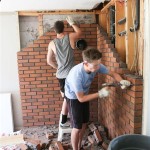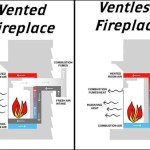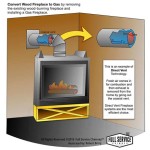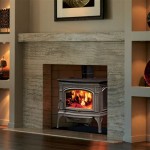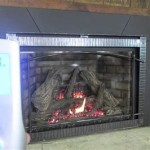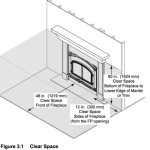Wood Burning Fireplace Outside Air: Enhancing Efficiency and Safety
Wood-burning fireplaces offer a timeless appeal, providing warmth and ambiance during colder months. However, their efficient and safe operation hinges on several factors, one of the most crucial being the availability of adequate combustion air. When a fireplace lacks sufficient air supply, it can lead to various problems, including poor combustion, smoke spillage, and even dangerous carbon monoxide buildup. Addressing this issue often involves incorporating an outside air kit, specifically designed to draw combustion air from the exterior of the home.
The importance of proper ventilation in wood-burning fireplaces stems from the fundamental principle of combustion. Fire requires oxygen to burn efficiently. In a typical house, a fireplace draws air from within the living space. This can create a negative pressure environment, potentially drawing in air from other sources, such as gaps around windows and doors, or even backdrafting from other combustion appliances like furnaces or water heaters. These alternative air sources can compromise the fireplace’s performance and introduce safety hazards.
An outside air kit is a system designed to provide a dedicated supply of fresh air for the fireplace. Typically, it consists of an intake vent located on the exterior of the house, connected to a duct that leads directly to the firebox of the fireplace. This allows the fireplace to draw combustion air from outside, bypassing the need to rely on the air within the home. By ensuring a consistent and adequate supply of fresh air, an outside air kit contributes to improved combustion efficiency, reduced smoke spillage, and enhanced overall safety.
Key Point 1: Addressing Negative Pressure and Backdrafting
Modern homes are often built with tighter construction standards, which, while beneficial for energy efficiency, can exacerbate the problem of negative pressure. Tightly sealed windows and doors, coupled with powerful exhaust fans in kitchens and bathrooms, can create a significant draw on indoor air. When a fireplace draws air from the home in such an environment, it can create a vacuum effect, pulling air from any available source. This is where the risk of backdrafting becomes particularly concerning.
Backdrafting occurs when the draft in a chimney reverses, causing exhaust gases, including carbon monoxide, to be drawn back into the living space. This can happen when the pressure inside the home is lower than the pressure outside, effectively overcoming the natural upward flow of the chimney. Combustion appliances like furnaces and water heaters, which also rely on venting exhaust gases through chimneys, are particularly vulnerable to backdrafting. If a fireplace creates sufficient negative pressure, it can interfere with the proper venting of these appliances, potentially leading to a dangerous buildup of carbon monoxide.
An outside air kit mitigates the risk of backdrafting by providing a dedicated air supply for the fireplace. By drawing air from the exterior, the fireplace does not contribute to the negative pressure inside the home, reducing the likelihood of interfering with the venting of other combustion appliances. This is especially important in homes with multiple combustion appliances or those with particularly airtight construction.
Key Point 2: Enhancing Combustion Efficiency and Reducing Smoke
Efficient combustion is essential for maximizing the heat output of a fireplace and minimizing the production of smoke and pollutants. When a fireplace lacks sufficient air, the wood does not burn completely, resulting in incomplete combustion. This incomplete combustion generates more smoke, creosote, and carbon monoxide than a properly burning fire. The smoke can be irritating to occupants and can also contribute to indoor air pollution. Creosote, a byproduct of incomplete combustion, is a flammable substance that can accumulate in the chimney and increase the risk of a chimney fire.
An outside air kit promotes more complete combustion by providing a consistent and ample supply of oxygen to the fire. When the fire has access to enough air, the wood burns more efficiently, producing more heat and less smoke. This not only improves the overall performance of the fireplace but also reduces the amount of creosote deposited in the chimney, decreasing the risk of a chimney fire. Furthermore, more complete combustion results in lower emissions of carbon monoxide and other pollutants, contributing to a healthier indoor environment.
The placement and design of the outside air intake vent are also crucial for optimal combustion efficiency. The vent should be located in a position where it is not susceptible to obstruction by snow, leaves, or other debris. It should also be positioned away from prevailing winds to prevent excessive drafts. Proper sizing of the ductwork connecting the vent to the firebox is also important to ensure adequate airflow. A correctly installed and maintained outside air kit can significantly improve the combustion efficiency of a wood-burning fireplace, resulting in a cleaner, safer, and more enjoyable fire.
Key Point 3: Installation Considerations and Building Codes
The installation of an outside air kit is generally a straightforward process, but it is important to follow manufacturer's instructions and local building codes. Some jurisdictions may require a permit for the installation of an outside air kit, particularly if it involves cutting through the exterior wall of the house. It is always advisable to consult with a qualified professional to ensure that the installation is performed correctly and in compliance with all applicable regulations.
The size of the air intake vent and ductwork should be appropriate for the size of the fireplace. A vent that is too small will not provide sufficient air, while a vent that is too large can create excessive drafts. The manufacturer's specifications typically provide guidance on the appropriate size of the components. The ductwork should be made of durable, non-combustible material, such as metal, and should be properly sealed to prevent air leaks. The intake vent should be equipped with a screen to prevent insects and debris from entering the ductwork.
Many building codes now require or recommend the installation of an outside air kit for new or renovated fireplaces. These codes recognize the importance of providing adequate combustion air for both safety and efficiency. When selecting and installing an outside air kit, it is important to be aware of the local code requirements and to ensure that the installation meets all applicable standards. Failure to comply with building codes can result in fines or other penalties.
Furthermore, the effectiveness of an outside air kit can be affected by other factors, such as the type of wood being burned, the design of the fireplace, and the overall ventilation of the home. Seasoned hardwood, such as oak or maple, burns more efficiently and produces less smoke than softwood, such as pine or fir. Fireplaces with airtight doors and adjustable air controls allow for more precise regulation of airflow, further enhancing combustion efficiency. Ensuring proper attic ventilation and crawl space ventilation also contributes to a balanced pressure environment within the home, which can improve the performance of the fireplace and reduce the risk of backdrafting.
In conclusion, the integration of an outside air kit represents a proactive approach to optimizing the performance and safety of wood-burning fireplaces. By addressing the issues of negative pressure, backdrafting, and incomplete combustion, an outside air kit contributes to a cleaner, more efficient, and safer heating experience. Proper installation, adherence to building codes, and attention to other contributing factors are essential for maximizing the benefits of this valuable addition to any wood-burning fireplace system.

Room Sealed Stoves With External Air Supply

Is It Mandatory To Connect The Outside Air Intake On Ecodesing Stoves Panadero

Better Burning Wood Stove With A External Air Intake

Direct Air Intake System Small Stove Salamander Stoves

Exterior Air For A Masonry Wood Burning Fireplace Jlc

Is It Mandatory To Connect The Outside Air Intake On Ecodesing Stoves Panadero

Outdoor Air Intakes Stûv America

What Is An Outdoor Air In Take Kit And Why All The Fuss Michigan Wood Pellet
Providing Outdoor Combustion Air For A Wood Stove Greenbuildingadvisor

Wood Stove Upgrade External Air Intake
Related Posts

